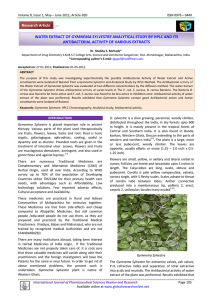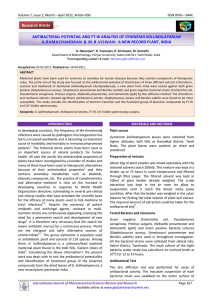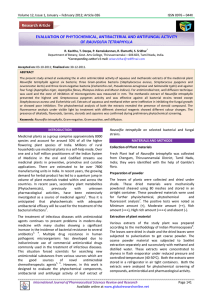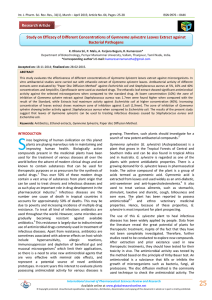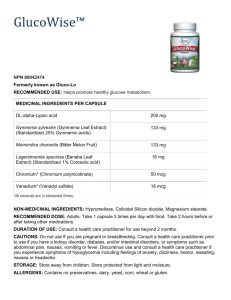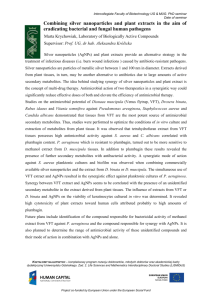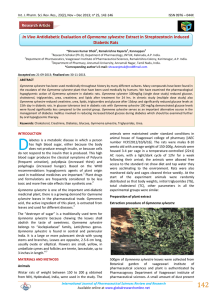Document 13308890
advertisement
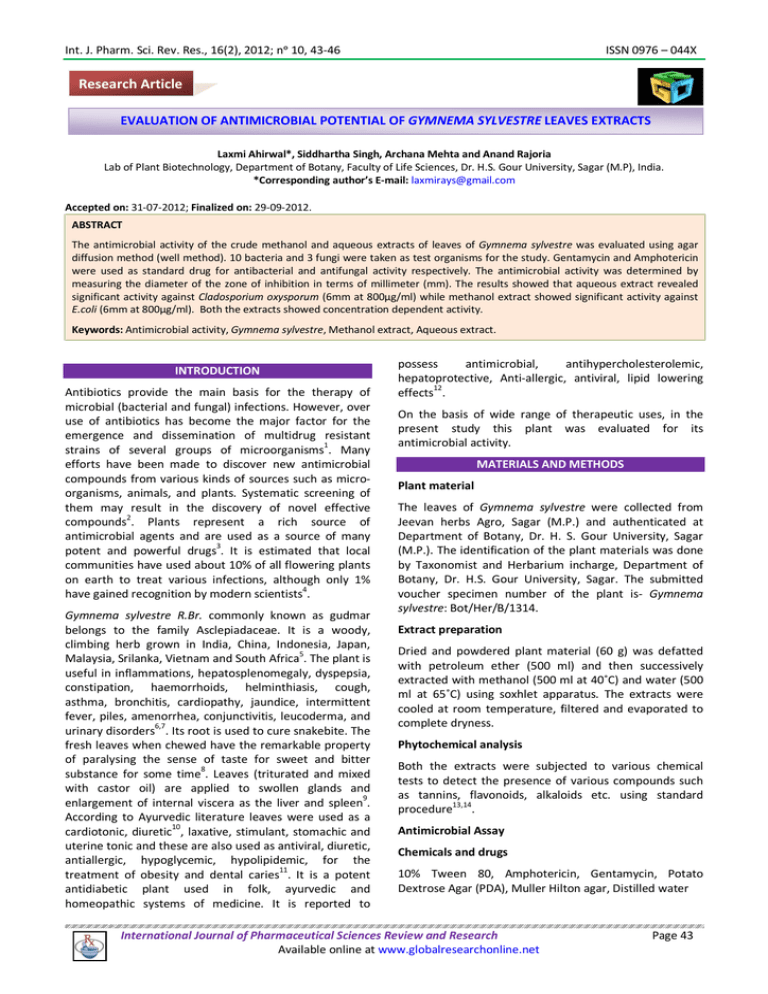
Int. J. Pharm. Sci. Rev. Res., 16(2), 2012; nᵒ 10, 43-46 ISSN 0976 – 044X Research Article EVALUATION OF ANTIMICROBIAL POTENTIAL OF GYMNEMA SYLVESTRE LEAVES EXTRACTS Laxmi Ahirwal*, Siddhartha Singh, Archana Mehta and Anand Rajoria Lab of Plant Biotechnology, Department of Botany, Faculty of Life Sciences, Dr. H.S. Gour University, Sagar (M.P), India. *Corresponding author’s E-mail: laxmirays@gmail.com Accepted on: 31-07-2012; Finalized on: 29-09-2012. ABSTRACT The antimicrobial activity of the crude methanol and aqueous extracts of leaves of Gymnema sylvestre was evaluated using agar diffusion method (well method). 10 bacteria and 3 fungi were taken as test organisms for the study. Gentamycin and Amphotericin were used as standard drug for antibacterial and antifungal activity respectively. The antimicrobial activity was determined by measuring the diameter of the zone of inhibition in terms of millimeter (mm). The results showed that aqueous extract revealed significant activity against Cladosporium oxysporum (6mm at 800µg/ml) while methanol extract showed significant activity against E.coli (6mm at 800µg/ml). Both the extracts showed concentration dependent activity. Keywords: Antimicrobial activity, Gymnema sylvestre, Methanol extract, Aqueous extract. INTRODUCTION Antibiotics provide the main basis for the therapy of microbial (bacterial and fungal) infections. However, over use of antibiotics has become the major factor for the emergence and dissemination of multidrug resistant strains of several groups of microorganisms1. Many efforts have been made to discover new antimicrobial compounds from various kinds of sources such as microorganisms, animals, and plants. Systematic screening of them may result in the discovery of novel effective compounds2. Plants represent a rich source of antimicrobial agents and are used as a source of many potent and powerful drugs3. It is estimated that local communities have used about 10% of all flowering plants on earth to treat various infections, although only 1% have gained recognition by modern scientists4. Gymnema sylvestre R.Br. commonly known as gudmar belongs to the family Asclepiadaceae. It is a woody, climbing herb grown in India, China, Indonesia, Japan, 5 Malaysia, Srilanka, Vietnam and South Africa . The plant is useful in inflammations, hepatosplenomegaly, dyspepsia, constipation, haemorrhoids, helminthiasis, cough, asthma, bronchitis, cardiopathy, jaundice, intermittent fever, piles, amenorrhea, conjunctivitis, leucoderma, and urinary disorders6,7. Its root is used to cure snakebite. The fresh leaves when chewed have the remarkable property of paralysing the sense of taste for sweet and bitter 8 substance for some time . Leaves (triturated and mixed with castor oil) are applied to swollen glands and 9 enlargement of internal viscera as the liver and spleen . According to Ayurvedic literature leaves were used as a cardiotonic, diuretic10, laxative, stimulant, stomachic and uterine tonic and these are also used as antiviral, diuretic, antiallergic, hypoglycemic, hypolipidemic, for the treatment of obesity and dental caries11. It is a potent antidiabetic plant used in folk, ayurvedic and homeopathic systems of medicine. It is reported to possess antimicrobial, antihypercholesterolemic, hepatoprotective, Anti-allergic, antiviral, lipid lowering effects12. On the basis of wide range of therapeutic uses, in the present study this plant was evaluated for its antimicrobial activity. MATERIALS AND METHODS Plant material The leaves of Gymnema sylvestre were collected from Jeevan herbs Agro, Sagar (M.P.) and authenticated at Department of Botany, Dr. H. S. Gour University, Sagar (M.P.). The identification of the plant materials was done by Taxonomist and Herbarium incharge, Department of Botany, Dr. H.S. Gour University, Sagar. The submitted voucher specimen number of the plant is- Gymnema sylvestre: Bot/Her/B/1314. Extract preparation Dried and powdered plant material (60 g) was defatted with petroleum ether (500 ml) and then successively extracted with methanol (500 ml at 40˚C) and water (500 ml at 65˚C) using soxhlet apparatus. The extracts were cooled at room temperature, filtered and evaporated to complete dryness. Phytochemical analysis Both the extracts were subjected to various chemical tests to detect the presence of various compounds such as tannins, flavonoids, alkaloids etc. using standard 13,14 procedure . Antimicrobial Assay Chemicals and drugs 10% Tween 80, Amphotericin, Gentamycin, Potato Dextrose Agar (PDA), Muller Hilton agar, Distilled water International Journal of Pharmaceutical Sciences Review and Research Available online at www.globalresearchonline.net Page 43 Int. J. Pharm. Sci. Rev. Res., 16(2), 2012; nᵒ 10, 43-46 Organisms used for the experiment Bacteria: Bacillus subtilis (MTCC 736), Bacillus polymyxa, Staphylococcus aureus (MTCC 3160), Escherichia coli (MTCC 723), Salmonella typhi (MTCC 3216), Vibrio cholerae (MTCC 3906), Streptococcus pyogenes (MTCC 1927), Proteus mirabilis (MTCC 1429), Providentia alkalifaciens, and Pseudomonas aeruginosa (MTCC 7837). Fungi: Aspergillus niger (MTCC 1881), Aspergillus flavus (MTCC 1883), Cladosporium oxysporum (MTCC 1777). Antimicrobial test For antibacterial assay, initially the stock cultures of bacteria were revived by inoculating in broth media and grown at 37˚C for 18 h. The agar plates of the Muller Hilton’s Agar media were prepared. Each plate was inoculated with an aliquot (0.1 ml) of the bacterial 5 6 suspension (10 -10 colony forming unit “CFU”/ml) which was spread evenly on the plate. After 20 min, wells were made with the help of cork borer in the plates and filled with test samples of different concentrations. The positive and negative control wells were filled with Gentamycin (Standard drug) and 10% Tween 80 respectively. All the plates were incubated at 37˚C for 24 h and then the diameter of zone of inhibition was noted. Similarly for the antifungal activity, the stock cultures of fungi were revived by inoculating in broth media and grown at 27˚C for 72 h. The agar plates of the Potato Dextrose Agar media were prepared. Each plate was inoculated with an aliquot (0.1 ml) of the fungal suspension (103 spores/ml) which was spread evenly on the plate. After 20 min, the wells were made and filled with test samples of different concentrations. The positive and negative control plates with Amphotericin (standard drug) and 10% Tween 80 were also prepared. All the plates were incubated at 27ᵒC for 72 h and then the diameter of zone of inhibition was noted15,16. RESULTS AND DISCUSSION In phytochemical analysis, methanol extract revealed the presence of alkaloids, tannins, saponins, flavonoids, glycosides and carbohydrates and the aqueous extract revealed the presence of tannins, saponins, carbohydrates and glycosides (Table 1). ISSN 0976 – 044X In the present studies, in antibacterial study, methanolic extract of G. sylvestre showed significant activity only against E. coli (2, 3, 4 and 6mm at 100, 200, 400 and 800 µg/ml respectively), negligible activity against B. subtilis (1mm at 800 µg/ml) while no activity was observed against S. aureus, V. cholerae, S. typhi, S. pyogenes, P. mirabilis, P. alkalifaciens, B. polymyxa and P. aeruginosa. Aqueous extract showed less activity against E. coli (2 mm at 800 µg/ml) and negligible activity against S. typhi (1 mm at 800 µg/ml) while no zone of inhibition was observed against S. aureus, V. cholerae, B. subtilis, S. pyogenes, P. mirabilis, P. alkalifaciens, B. polymyxa and P. aeruginosa (Table 2; Figure 1). Methanolic extract of G. sylvestre showed maximum antibacterial activity. In case of antifungal study, all the fungal strains (Aspergillus niger, Cladosporium oxysporum, Aspergillus flavus) tested, were found resistant against methanolic extract of G. sylvestre, whereas aqueous extract showed significant activity against Cladosporium oxysporum (2, 4 and 6 mm at 200, 400 and 800 µg/ml respectively), moderate activity against Aspergillus flavus (2 mm at 800 µg/ml) and no activity against Aspergillus niger (Table 3; Figure 2). Both the extracts showed concentration dependent activity. Aspergillus niger was found resistant against all the extracts. From the above results it can be concluded that plant extracts have significant potential against microorganisms and they can be used in the treatment of infectious diseases caused by resistant microorganisms. GSM: Gymnema sylvestre methanol extract; GSA : Gymnema sylvestre aqueous extract; - : no activity; mm : millimeter Figure 1: Antibacterial activity of methanolic and aqueous extract of G. sylvestre leaves Table 1: Phytochemical analysis of methanol and aqueous extracts of G. sylvestre leaves Phytochemical Steroids Terpenoids Tannins Alkaloids Glycosides Flavonoids Saponins Methanol Extract + + + + + +: Present; - : Absent Aqueous Extract + + + GSM: Gymnema sylvestre methanol extract; GSA : Gymnema sylvestre aqueous extract; - : no activity; mm : millimeter Figure 2: Antifungal activity of methanol and aqueous extracts of Gymnema sylvestre leaves International Journal of Pharmaceutical Sciences Review and Research Available online at www.globalresearchonline.net Page 44 Int. J. Pharm. Sci. Rev. Res., 16(2), 2012; nᵒ 10, 43-46 ISSN 0976 – 044X Table 2: Antibacterial activity of methanol and aqueous extracts of Gymnema sylvestre leaves E. coli S. aureus B. subtilis S. typhi V. cholerae S. pyogenes P. mirabilis P. alkalifaciens B. polymyxa P. aeruginosa Zone of Inhibition (mm) Organism - - - - - - - - - - 50 - - - - - - - - - 100 2 3 - - - - - - - - - 400 800 4 - - - - - - - - - 6 - 1 - - - - - - - 25 - - - - - - - - - - 50 100 - - - - - - - - - - 200 - - - - - - - - - - 400 800 - - - - - - - - - - 2 - - 1 - - - - - - - - - - - - - - - - - 25 18 13 8 2 13 19 9 20 15 - 50 100 20 18 10 13 15 22 13 23 22 - 23 21 15 16 18 25 18 26 25 1 200 26 25 19 21 21 28 21 31 28 3 28 27 800 30 34 - : no activity; mm : millimeter 22 25 25 27 23 25 30 33 25 27 35 38 30 33 8 14 Test Sample Conc (µg/ml) 25 Gymnema sylvestre methanol extract Gymnema sylvestre aqueous extract Control (10% Tween 80) Standard drug (Gentamycin) 200 400 Table 3: Antifungal activity of methanol and aqueous extracts of Gymnema sylvestre leaves Concentration (µg) Test sample 25 50 100 200 400 800 25 50 100 200 400 800 GSM GSA Control (10% Tween 80) 800 Zone of Inhibition (mm) A. C. A. niger oxysporum flavus 2 5 6 2 - 25 50 100 2 Standard drug (Amphotericin) 200 3 400 5 800 7 GSM: Gymnema sylvestre methanol extract GSA: Gymnema sylvestre aqueous extract - : no activity; mm : millimeter - - 2 7 9 13 15 7 10 Antimicrobial agents can damage pathogens in several ways. Most antimicrobial agents used for the treatment - of bacterial infections may be categorized according to their principal mechanism of action. The major modes of actions are interference with cell wall synthesis, inhibition of protein synthesis, interference with nucleic acid synthesis, and inhibition of a metabolic pathway17. The most selective antimicrobial agents are those that interfere with the synthesis of bacterial cell walls, e.g. penicillin, cephalosporin etc. These drugs have high therapeutic index because bacterial cell walls possess a unique structure, not found in eukaryotic cells18. Plants are important source of potentially useful structures for the development of new chemotherapeutic agents and the first step towards this goal is in vitro antibacterial activity assay19. Many reports are available on the antiviral, antibacterial and antifungal properties of plants20,21. Some of these observations have helped in identifying the active principle responsible for such activities and in developing drugs for the therapeutic use in human welfare. Plants with possible antimicrobial activity should be tested against an appropriate microbial model to confirm the activity and to ascertain the parameters associated with it. The effects of plant extracts on bacteria have been studied by a large number of researchers in different parts of the world22-24. It has been suggested that aqueous and ethanolic extracts from plants used in allopathic medicine are potential sources of antiviral, antitumor and antimicrobial agents25,20. International Journal of Pharmaceutical Sciences Review and Research Available online at www.globalresearchonline.net Page 45 Int. J. Pharm. Sci. Rev. Res., 16(2), 2012; nᵒ 10, 43-46 CONCLUSION As reported earlier secondary metabolites like tannins, saponins, flavonoids are likely responsible for the 26-28 observed antibacterial activity of the plants it can be concluded that the antimicrobial activity showed by the extracts of Gymnema sylvestre is due the presence of these phytochemicals. From the above results it can be concluded that plant extracts have potential as antimicrobial compounds against microorganisms and they can be used in the treatment of infectious diseases caused by resistant microorganisms. The results of the present study reveal the antimicrobial properties of Gymnema sylvestre and thus these plants can be used as new drug for the treatment of infectious diseases caused by bacterial and fungal pathogens. Acknowledgement: The authors are grateful to the Head, Department of Botany, Dr. H.S. Gour University, Sagar (M.P.) for providing the facilities. REFERENCES 1. Singh K, Tiwari V, Prajapat R, Study of Antimicrobial Activity of Medicinal Plants against Various Multiple Drug Resistance Pathogens and their Molecular Characterization and its Bioinformatics Analysis of Antibiotic Gene From Genomic Database With Degenerate Primer Prediction. International Journal of Biological Technology, 1(2), 2010, 15-19. 2. Tomoko N, Takashi A, Hiromu T, Yuka I, Hiroko M, Munekazu I, Totshiyuki T, Tetsuro I, Fujio A, Iriya I, Tsutomu N, Kazuhito W, Antibacterial activity of extracts preparated from tropical and subtropical plants on methicillin-resistant Staphylococcus aureus. J Health Sci, 48, 2002, 273–276. 3. Srivastava J, Lambert J, Vietmeyer N, Medicinal plants: An expanding role in development. World Bank Technical Paper, 320, 1996, 18. 4. Lewis K and Ausubel FM, Prospects of plant derived antibacterials, Nat Biotechnol, 24, 2006, 1504-1507. 5. Bone K. Official home page of Gymnema: A key herb in the management of diabetes. http://www.townsendletter.com, March 18, 2007. 6. Sharma PV, Dravyaguna Vijnana, (in Hindi), Varanasi, 1983. 7. Nadkarni KM, Indian Materia Medica, 1, Popular Prakashan, Bombay, 1993, 596-599. 8. Warrier PK, Nambiar VPK, Ramankutty C, Indian Medicinal Plants, l, Orient Longman Ltd, Madras, 1995, 1-5. 9. Nadkarni AK, Indian Materia Medica, Popular Prakashan, Bombay, 1954. 10. Reddy S, Gopal G, Sit G, In vitro multiplication of Gymnema sylvestre R Br: An important medicinal plant, Curr Sci, 10, 2004, 14. ISSN 0976 – 044X 11. The Ayurvedic Pharmacopoeia of India, Part-I, 1st Ed, Government of India, Ministry of Health and Family Welfare Department of Indian System of Medicine and Homoeopathy, New Delhi, 5, 2006, 123-124. 12. Porchezhian E, Dobriyal RM. An overview on the advances of Gymnema sylvestre: chemistry, pharmacology and patents, Pharmazie, 58(1), 2003, 5-12. rd 13. Harborne JB, Phytochemical methods, 3 edition, Chapman & Hall, London, 1988, 117-119. th 14. Trease GE, Evans WC, A textbook of Pharmacognosy 11 edition, Bailliere Tindall, London, 1978, 530. 15. Selvamani P, Latha S, Antimicrobial activity of crude extracts of Cassia alata. Indian J Nat Prod, 20, 2004, 30-32. 16. Zhu XF, Zhang HX, Lo R, Antifungal activity of Cynara scolymus L. extracts, Fitoterapia, 76, 2005, 108-111. 17. Neu HC, The crisis in antibiotic resistance, Science, 257, 1992, 1064-1073. 18. Purohit SS, Microbiology Fundamentals and applications, 6th ed, Agrobios, India, 2000, 647-648. 19. Tona L, Kambu K, Ngimbi N, Cimanga K, Vlietinck AJ, Antiamoebic and phytochemical screening of some Congolese medicinal plants, J Ethnopharmacol, 61, 1998, 57-65. 20. Vlietinck AJ, Van Hoof L, Tott J, Lasure A, Vanden Berghe D, Rwangabo PC, Mvukiyumwami J, Screening of hundred Rwandese medicinal plants for antimicrobial and antiviral properties, J Ethnopaharmacol, 46, 1995, 31-47. 21. Samy RP, S Ignacimuthu, Antibacterial activity of some folklore medicinal plants used by tribals in Western Ghats in India, J Ethnopharmacol, 69, 2000, 63-71. 22. Reddy PS, Jamil K, Madhusudhan P, Antibacterial activity of isolates from Piper longum and Taxus baccata, Pharmaceutical Biol, 39, 2001, 236-238. 23. Erdogrul OT, Antibacterial activities of some plant extracts used in folk medicine, Pharmaceutical Biol, 40, 2002, 269-273. 24. Ates DA, Erdogrul OT, Antimicrobial activities of various medicinal and commercial plant extracts, Turk J Biol, 27, 2003, 157-162, 25. Chung TH, Kim JC, Kim MK, Choi SC, Kim SL, Chung JM, Lee IS, Kim SH, Hahn KS, Lee IP, Investigation of Korean plant extracts for potential phytotherapeutic agents against B-virus Hepatitis, Phytotherapy Res, 9, 1995, 429-434. 26. Lutete T, Kambu K, Ntondele D, Cimanga K, Luki N, Antimicrobial activity of tannins, Fitoterapia, 65(3), 1994, 276-278. 27. Bose A, Gupta JK, Dash GK, Ghosh T, Si S, Panda DS, Diuretic and antibacterial activity of aqueous extract of Cleome rutidosperma D.C., Indian J Pharm Sci, 69(2), 2007, 292-294. 28. Tsuchiya H, Sato M, Miyazaki T, Fujiwara S, Tanigaki S, Ohyama M, Tanaka T, Iinuma M, Comparative study on the antibacterial activity of phytochemical flavanones against methicillin-resistant Staphylococcus aureus, Journal of Ethnopharmacology, 50, 1996, 27-34. ************************ International Journal of Pharmaceutical Sciences Review and Research Available online at www.globalresearchonline.net Page 46
